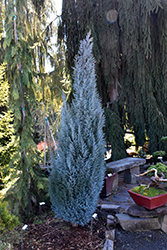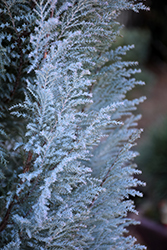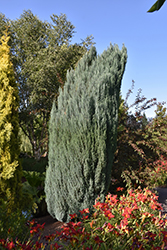It's all about ...
plants

Blue Surprise Port Orford Cedar
Chamaecyparis lawsoniana 'Blue Surprise'
Height: 15 feet
Spread: 5 feet
Sunlight:
![]()
![]()
Hardiness Zone: 6a
Other Names: Lawson Falsecypress, Oregon Cedar
Group/Class: The Guardian® Series
Brand: Monrovia
Description:
A dense, upright, and narrowly columnar accent or articulation plant, with breathtaking steel blue sprays of fine foliage; takes on a purple cast in winter; remains dwarf and compact without pruning, the ideal size for the garden; a fine color accent
Ornamental Features
Blue Surprise Port Orford Cedar is a dwarf conifer which is primarily valued in the landscape for its rigidly columnar form. It has attractive steel blue evergreen foliage. The scale-like sprays of foliage are highly ornamental and remain steel blue throughout the winter. The shaggy antique red bark adds an interesting dimension to the landscape.
Landscape Attributes
Blue Surprise Port Orford Cedar is a multi-stemmed evergreen shrub with a narrowly upright and columnar growth habit. It lends an extremely fine and delicate texture to the landscape composition which can make it a great accent feature on this basis alone.
This is a relatively low maintenance shrub, and should not require much pruning, except when necessary, such as to remove dieback. It has no significant negative characteristics.
Blue Surprise Port Orford Cedar is recommended for the following landscape applications;
- Accent
- Vertical Accent
- Hedges/Screening
- General Garden Use
Planting & Growing
Blue Surprise Port Orford Cedar will grow to be about 15 feet tall at maturity, with a spread of 5 feet. It tends to fill out right to the ground and therefore doesn't necessarily require facer plants in front, and is suitable for planting under power lines. It grows at a slow rate, and under ideal conditions can be expected to live for 50 years or more.
This shrub does best in full sun to partial shade. It does best in average to evenly moist conditions, but will not tolerate standing water. It is not particular as to soil type, but has a definite preference for acidic soils. It is somewhat tolerant of urban pollution. Consider applying a thick mulch around the root zone in winter to protect it in exposed locations or colder microclimates. This is a selection of a native North American species.
This plant is not reliably hardy in our region, and certain restrictions may apply; contact the store for more information.


